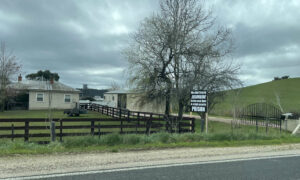Michael Buxton
Read the full with Professor Michael Buxton interview at:
http://friendsoftheeastcoast.org/prof-buxton-interview.html
Website www.friendsoftheeastcoast.org
Cambria Green Project Dolphin Sands $100 million project
WHAT WE KNOW:
Size: 3,185 ha (7,870 acres)
Accommodation:
Cambria Sky Hotel 100-120 luxury rooms
Villas 70
Units 240
Health retreat 80 units palliative care unit
Apartments 80
Facilities wedding, function, conference
Village: restaurants, shops, cafes, pharmacy, dental clinic, art gallery, gymnasium, children play area, organic farming spaces
Golf courses: 9-hole and 18-hole
Airstrip: for fly-in guests, scenic flights, Flying Doctor Service
Comment:
The project appears aimed exclusively at overseas visitors, particularly from China and Hong Kong:
• Cambria Green CEO Ronald Hu The Mercury 24/4/18 “This will attract a certain type of high-end tourist…”
• Irene Duckett on the ABC 24/4/18 about the palliative care unit “there was a market in China for such a service, for those who could afford it, because of the erosion of the extended family”
Next steps
The Glamorgan Spring Bay Council has now decided to seek an amendment to their planning scheme to allow the porject.
This amendment will be released for public comment in May for 42 days, and then sent to the Tasmanian Planning Commission.
The Commission would then undertake a public review before approving the proposed zoning changes to allow the project to proceed.
If and when the planning scheme is amended, the developer would then submit a Development Application for the proposal.
FRIENDS of the EAST COAST prediction:
From an interview with Prof Michael Buxton November 2016.
“the tourist issue in the rural zones”
“Finally the tourist issue in the rural zones. This is really going to lead to big problems, particularly in your high scenic areas like the East Coast and the North-East Coast. You are going to have major tourist developments in some of the most scenic areas.
There will be widespread misapplication of zones particularly in rural areas. That’s our experience right across the country. On the East Coast in the two main rural zones, the most development oriented rural zone will be applied most. Councils in applying these zones won’t apply the strongest rural zone.
In Victoria which has relatively sophisticated planning expertise, we found there was widespread misapplication of zones, the strongest zone was hardly used, because land owners had control of the council, some councillors were large landowners or landowners influenced councillors and didn’t like the strongest zones. So the weaker zones are applied.
Problems with major integrated tourist developments
Aside from misapplication of rural zones the new planning scheme is going to allow major integrated tourist developments, visitor accommodation, and commercial uses. This will attract national and international investors without a doubt. It may take some time to gradually build up but Tasmania already is seen as a potentially major tourist destination in its most scenic areas not just in places like Hobart and in Parks. So it is expected that increased national and international visitor pressure will affect development interest on the most scenic areas of the Tasmanian eastern and north east coasts.
Now the preference for these big resort developers is to have integrated resorts with conference centres, massive visitor accommodation of various kinds, from hotel to cabins; all sorts of accommodation types, recreation, restaurants; all integrated. Developers want to isolate their resorts from townships, to capture most of the dollar at the most scenic places. That means they’ll privatise the most scenic landscapes that are publicly accessible now. People in a way have some measure of involvement with scenic places because we can see them, use them, walk on the beach, and so on. Now once you build these resorts, walls go up and people are excluded from participating in these wonderful scenic experiences.
“very little benefit to the economy of local towns”
So aside from the loss of these most beautiful areas because these are the places these resorts are going to pick, there is going to be virtually no benefit or very little benefit to the economy of local towns. Resort owners don’t want the dollar to accrue to the townships. There might be a few people making beds and so on, but the resort workers will live at the resort, the transport to and from the resort will be strictly controlled. There is very little benefit to the township. Nobody’s trying to stop visitor accommodation or tourist investment, but location is the issue. If a regulated planning approach says you can have these but you’ve got to have them in or near townships, then the town can benefit.
“stand alone resorts privatise a public benefit for private gain”
The classic comparison is New Zealand where New Zealanders built a significant part of the country’s economy around high quality, value added supply chains in agriculture and tourism and recreation visitor accommodation. So people come into New Zealand from all over the world to experience high quality recreation, tourism and scenic landscapes. The approach the New Zealand Government takes is that it protects its scenic assets because they’re what people come to see. So visitors usually have to stay in or near townships. So you drive out of the town to experience the delights of the South Island, for example. And that means that those scenic areas that people come to experience are protected and they’re not privatised. In effect stand alone resorts privatise a public benefit for private gain.
Secondly the towns benefit. Towns like Queenstown (NZ) are lively places with everything from restaurants to night clubs, to tourist developments, but also the support services because people actually live in the towns. There are medical, educational support services business support, advice, accountants, high end professional services as well – a range of employment opportunities offered. You can walk around the town because you’re staying in the town, or you’re staying on the edge of the town, and so you go to hotel bars, restaurants, but also go to the cultural facilities. Small businesses gain. So the aim should be for towns to experience growth not just in the low end jobs making beds, but right through the employment chain to the high end professional services. Great benefits and few disadvantages arise from locating overseas and national investment in the towns.
“it’s going to leave towns languishing”
Now if Tasmania doesn’t wake up to this, it’s going to do two things: destroy its most scenic landscapes excluding all but the privileged few, and secondly it’s going to leave towns languishing. So the people of Tasmania are going to be the losers in both ways.”
Graeme Wathen


























Luke Martin
April 25, 2018 at 20:30
What a load of total rubbish!
Tourism in Queenstown – and indeed New Zealand generally – is hardly a model for the East Coast or anywhere else in Tasmania.
There are 2 million annual visitors to Queenstown who spend on average 1.5 nights in the region. They fly and drive in and out for short burst stays, and put immense pressure on the local community of 30,00 people. It’s mass tourism on steroids and God forbid any part of Tasmania ever resembles the structure and make up of our South Island friends.
New Zealand has also pioneered the concept of lodge developments that are all about integrated visitor experiences in regional destinations.
Tasmania’s average length of stay is 8 nights. Our visitors stay longer, spend more and disperse further into regional parts of the State. The challenge for regional destinations like the East Coast are to maximise their share of the visitor spend pie through a diverse mix of complimentary visitor facilities and experiences that appeal to different market segments. That’s how you build sustainability in destinations so that if one market segment softens, others might hold-up.
This Cambria Green development is not the panacea for East Coast Tourism, nor is it likely to represent a signficiant piece of the visitor market to the region now. But it will cater to a market segment that is currently not serviced. Like the region’s multi-day walks cater to a certain market, its wineries, its B&Bs;..
And please, if you’re going to refer to another destination to make a point about Tasmania tourism, at least do your homework!